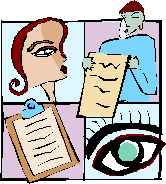 |
Student Area: Experiments to Try at HomeDream Experiments |
|
|
|
|
|
These simple experiments are fun to try at home. Any time you are studying and changing your own sleep, it is a good idea to do it on a week-end, vacation, or other time when it is not important to be well-rested. And if you do lose any sleep, be extra-careful the next day! 1. Dream interviews First, sit and write down (in a sentence or two) descriptions of THREE different dreams:
Next, choose several people to interview. (Relatives and friends are good choices.) Ask them to describe the same three dreams: earliest, most memorable, and most recent. Don’t tell them anything about your dreams until they have finished telling you about theirs – that could influence how they might answer! (But it is fun to share your own answers with them, once they are done with their stories.) Take notes – just like a newspaper reporter would – about their answers. When you are finished with the interviews, compare all the dreams. Do you notice anything that any of the dreams have in common? Any big surprises? Are the memorable dreams (including the earliest ones) usually happy or scary? Why do you think we remember some dreams for so long, while others fade away so quickly? 2. Dream triggers |
|
Click to see the ASD's suggestions for Science Projects about dreams. For more fun sleep & dream experiments, check out the Neuroscience for Kids web site. For an experiment on gender and dreams, visit this web site. Click to see suggestions for the Quantitative Study of Dream Content. |
|
|
Click the following link to go to another web site to learn more about Alfred Maury. |
A doctor named Alfred Maury did many different experiments studying his own dreams, back in the 1800’s. For example, he used scents – like perfumes – to try to trigger or change his dreams. Here’s how it worked: he would have someone else creep into his room at night and put a few drops of perfume on his pillow, to see how it affected his dreams. (He did some complicated things ahead of time, to try to associate certain scents with certain new places he traveled, but you don’t need to do that part.) To do this experiment, you’ll need to get into the habit of remembering your dreams. You’ll also need the help of a partner (a parent would be good) who lives at your house and doesn’t mind waking up earlier than you do. Have your partner creep into your room before you are awake and do certain things (suggestions are listed below) to influence or trigger dreams. Since people tend to have more dreams – and longer ones – toward the end of the night, the best time might be an hour or so before you usually wake up. So what is your partner supposed to do? They need to put things near you – things that you might notice in your sleep, without waking up – that could affect your dreams. These items should be left in your room until you wake up. (You should not know ahead of time, exactly what items they choose.) Here are some suggestions: |
Then when you wake up, write down your dreams. See if your dreams were affected by the information picked up by your senses, while you were sleeping. You will want to share your dreams with your partner, too. After all, they went to a lot of trouble to help you out!
|